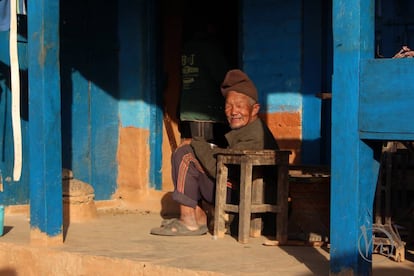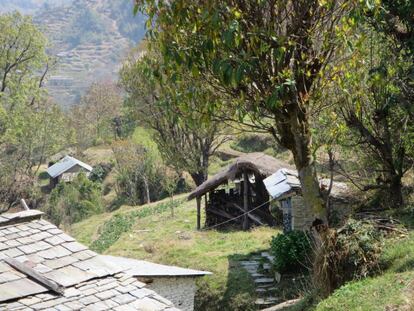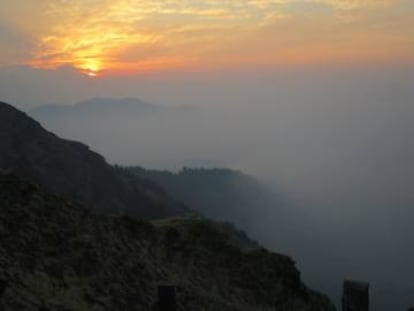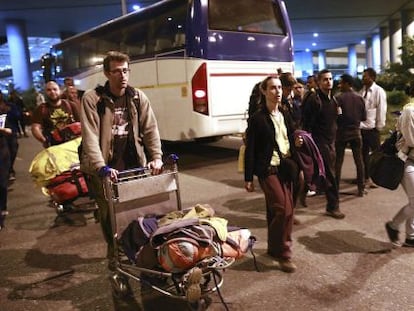Discovering Shangri La on a community-organized trek in Nepal
A network of small hamlets in the Himalayas funds schools and clinics with the proceeds from adventure holidays

In a world dominated by large corporations, it's good to know that in some remote pockets, communities are taking their own initiatives to improve their lives. And, judging by my experience in the foothills of the Himalayas, they mean business.
When I mobilized my first group of Nómadas Solidarios, a small not-for-profit organization based in the mountains outside Madrid, and set out to join the Nepal Community Trek, my traveling companions and I found local people operating with impressive efficiency to provide an idyllic experience far from the madding crowds of the Annapurna circuit and other well-worn trekking routes.
Run by an association of rural hamlets in the Annapurna-Dhaulagiri region, northwest of Pokhora, the Nepal Community Trek was set up by local visionary and social entrepreneur Mahabir Pun and his Himanchal Education Foundation to raise funds for local education and health as well as providing villagers directly involved with a source of income. “This was the first model of its kind in Nepal run by the community for the community,” trek coordinator Chitra Pun told us. “It has helped the people here open up and grow in confidence. It has been very empowering.”

Inspired by this approach, we laced our boots and prepared to go up in the world, leaving the road – such as it was – at the dusty village of Galeshwor. The climb was an arduous three hours. It took us up an endless rough-hewn stairway that cut through orange groves and the occasional small farmstead to the secluded village of Banskharka where our guide’s cousin shared his home with us in the shadow of the majestic Dhaulagiri, the world’s seventh highest peak at 26,794ft.
Coming from the noisy, traffic-ridden city of Madrid, it was disconcerting to find no wheeled vehicles here, as though the concept had never been invented. Instead, oxen plowed the fields and villagers carried wood and food in vast wicker baskets strapped to their foreheads.
Fresh organic vegetables and mounds of steaming rice helped to fuel our climb upwards another 3,280ft the next day to the village of Nangi, center of trekking operations and home to the community’s main school and clinic.

The village was abuzz with activity and the erratic electricity supply meant that instead of working their PlayStations, the children climbed trees, gathered in groups for games played with stones or spontaneously burst into song while we spent an industrious hour scrubbing our clothes under the tap in the lodge’s garden.
Clichéd though it may sound, this corner of Nepal is the land that time forgot. In the absence of proper roads, cars are few and far between and we never saw a television or home appliance. It is a place so remote that the 20th century failed to reach it. And yet, surprisingly enough, it has WiFi, one of Mahabir Pun’s many achievements. The children learn to work computers in school, prompting the uneasy thought that it will not be long before their wild and free childhoods are traded in for screen-time.
The highest point of our trek was 10,826ft at Mohare and to get there we hiked through magnificent rhododendron forests whose colors splashed crimson and pink against the forbidding snowy peaks of Dhaulagiri and Annapurna.

The view from Mohare at sunrise was magnificent and we knew that we would never look at Madrid's Guadarrama mountains in the same way again. Cloud drifted below summits that seemed to draw ever closer as dawn broke. “The mountain is rising,” our guide Prem Pun said, becoming disarmingly poetic, and adding: “that's how we describe the phenomenon in Nepal.”
This was the high point of the trip, and we would now have to begin our descent. This took us into the Annapurna circuit, breaking the spell of the previous days. Here, there were tourists aplenty and children strategically placed en route to extract sweets and pens. We ended our eight days with the Nepal Community Trek in the spa town of Tatopanni where we soaked in the scalding thermal pools while contemplating Nilgiri, a commanding 23,166ft presence in the valley. But as colorful buses and four wheel drives churned along the dust track above us, we were more aware than ever that we had left Shangri La and were back in the world of wheels and deals of a more familiar kind.
For more information: www.nomadassolidarios.org
Tu suscripción se está usando en otro dispositivo
¿Quieres añadir otro usuario a tu suscripción?
Si continúas leyendo en este dispositivo, no se podrá leer en el otro.
FlechaTu suscripción se está usando en otro dispositivo y solo puedes acceder a EL PAÍS desde un dispositivo a la vez.
Si quieres compartir tu cuenta, cambia tu suscripción a la modalidad Premium, así podrás añadir otro usuario. Cada uno accederá con su propia cuenta de email, lo que os permitirá personalizar vuestra experiencia en EL PAÍS.
¿Tienes una suscripción de empresa? Accede aquí para contratar más cuentas.
En el caso de no saber quién está usando tu cuenta, te recomendamos cambiar tu contraseña aquí.
Si decides continuar compartiendo tu cuenta, este mensaje se mostrará en tu dispositivo y en el de la otra persona que está usando tu cuenta de forma indefinida, afectando a tu experiencia de lectura. Puedes consultar aquí los términos y condiciones de la suscripción digital.
More information
Últimas noticias
The complicated life of Francesca Albanese: A rising figure in Italy but barred from every bank by Trump’s sanctions
How Japan is trying to avert ‘digital defeat’
Half of Scotland is in the hands of 420 property owners
Reinhard Genzel, Nobel laureate in physics: ‘One-minute videos will never give you the truth’
Most viewed
- Pablo Escobar’s hippos: A serious environmental problem, 40 years on
- Why we lost the habit of sleeping in two segments and how that changed our sense of time
- Charles Dubouloz, mountaineering star, retires at 36 with a farewell tour inspired by Walter Bonatti
- Reinhard Genzel, Nobel laureate in physics: ‘One-minute videos will never give you the truth’
- The Florida Keys tourist paradise is besieged by immigration agents: ‘We’ve never seen anything like this’










































